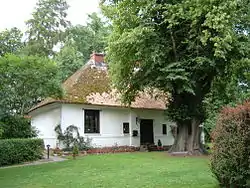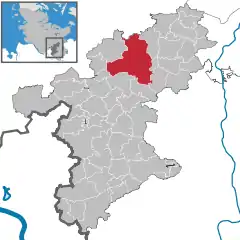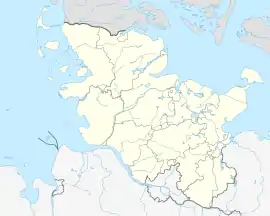Bad Oldesloe
Bad Oldesloe (German pronunciation: [ˈbaːt ˌɔldəsˈloː]) is a town located in the northern German state of Schleswig-Holstein. It is the capital of the district of Stormarn.
Bad Oldesloe | |
|---|---|
 House that Menno Simons is believed to have worked in | |
 Coat of arms | |
Location of Bad Oldesloe within Stormarn district  | |
 Bad Oldesloe  Bad Oldesloe | |
| Coordinates: 53°48′42″N 10°22′27″E | |
| Country | Germany |
| State | Schleswig-Holstein |
| District | Stormarn |
| Government | |
| • Mayor | Jörg Lembke |
| Area | |
| • Total | 52.6 km2 (20.3 sq mi) |
| Elevation | 9 m (30 ft) |
| Population (2019-12-31)[1] | |
| • Total | 24,690 |
| • Density | 470/km2 (1,200/sq mi) |
| Time zone | UTC+01:00 (CET) |
| • Summer (DST) | UTC+02:00 (CEST) |
| Postal codes | 23843 |
| Dialling codes | 04531 |
| Vehicle registration | OD |
| Website | www.badoldesloe.de |
The area has been inhabited since Mesolithic times. The flint tools found here from that era (6000–4500 BC) are clearly defined and known as the Oldesloer Stufe. For a number of years in the 18th Century the Moravian Church had a congregation in Bad Oldesloe. It was called "Pilgerruh", i.e. "Pilgrims' Rest". It was given up because of difficulties with the Danish Church authorities. At that time, the Duchy of Holstein was ruled by the kings of Denmark within the Holy Roman Empire.
On 24 April 1945 the town was heavily bombed by Allied forces in the final days of the Second World War in Germany. Three hundred buildings were destroyed, and 706 people were killed as a result of the operation.[2]
Buildings
16th century Mennokate: Memorial for Menno Simons, founder and eponym of the Mennonites, a group of anabaptists. He had some of his works printed in this building.
Transport
Bad Oldesloe station is located on the Lübeck–Hamburg and the Neumünster–Bad Oldesloe railways.
Notable people
- Hermann Olshausen (1796–1839), theologian
- Otto Wilhelm Sonder (1812–1881), botanist and pharmacist
- Theodor Mommsen (1817–1903), classical scholar, historian, jurist, journalist, politician, archaeologist, writer, and classicist
- August Mommsen (1821–1913), historian
- Klaus Bargsten (1911–2000), captain and sole survivor of sunken U-521
- Henning Schwarz (1928–1993), CDU politician
- Isa Genzken (born 1948), sculptress and contemporary artist
- Rüdiger Schmidt-Grépály (born 1952), Cultural Manager at the Klassik Stiftung Weimar
- Axel Hager (born 1969), beach volleyball player; won bronze medal at the 2000 Sydney Olympics (grew up in Bad Oldesloe)
- Katharina Fegebank (born 1977), politician (The Greens)
- Rouwen Hennings (born 1987), football player
- Julia Görges (born 1988), tennis player
- Maximilian Ahlschwede (born 1990), football player
- Dan-Patrick Poggenberg (born 1992), football player
- Wincent Weiss (born 1993), singer and model
- Dren Feka (born 1997), professional footballer
Twin towns – sister cities
Bad Oldesloe is twinned with:[3]
 Be'er Ya'akov, Israel
Be'er Ya'akov, Israel Jifna, Palestine
Jifna, Palestine Kołobrzeg, Poland
Kołobrzeg, Poland Olivet, France
Olivet, France
References
- "Statistikamt Nord – Bevölkerung der Gemeinden in Schleswig-Holstein 4. Quartal 2019 (XLS-file)". Statistisches Amt für Hamburg und Schleswig-Holstein (in German).
- Kuhlmann-Schultz, Kerstin (10 September 2014). "24. April 1945 — Oldesloes schwarzer Tag" [24 April 1945 - Oldesloe's black day]. Lübecker Nachrichten (in German). Retrieved 3 May 2019.
- "Partnerstädte im Überblick und Mitgliedschaft im Hiroshima-Solidaritätsbündnis". badoldesloe.de (in German). Bad Oldesloe. Retrieved 2021-02-04.